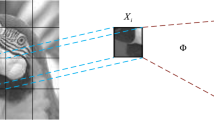Abstract
Traditional iterative-based reconstruction algorithms for compressed color imaging often suffer from long reconstruction time and low reconstruction accuracy at extreme low-rate subsampling. This paper proposes a model-driven deep learning framework for compressed color imaging. In the training step, extract the image blocks at the same position of the R, G, and B channel images as the ground truth, and then, singular value decomposition is performed on the measurement matrix to obtain the optimized measurement matrix and low-dimensional measurements; afterward, the ground-truth and optimized measurements are utilized to construct a large amount of training data pairs to train an ‘end-to-end’ deep unfolding model for compressed color imaging. In the test step, the single pretrained model is used to reconstruct high-quality images from optimized low-dimensional compressed measurements for each channel and synthesize a color image. Numerical experiments demonstrate that our proposed unified framework can achieve high accuracy and real-time reconstruction for the color image at extremely low subsampling rate.






Similar content being viewed by others
Data availability
Enquiries about data availability should be directed to the authors.
References
Bai C, Qian J, Dang S, Peng T, Min J, Lei M, Yao B (2020) Full-color optically-sectioned imaging by wide-field microscopy via deep-learning. Biomed Opt Express 11(5):2619–2632
Donoho DL (2006) Compressed sensing. IEEE Trans Inf Theory 52(4):1289–1306
He K, Zhang X, Ren S, et al. (2016) Deep residual learning for image recognition. roceedings of the IEEE conference on computer vision and pattern recognition. 770–778
Kingma D and Ba J (2014) Adam: A method for stochastic optimization. arXiv preprint arXiv:1412.6980
Kulkarni K et al. (2016) Reconnet: Non-iterative reconstruction of images from compressively sensed measurements. Proceedings of the IEEE Conference on Computer Vision and Pattern Recognition
Kuntao Ye, Jifeng L, Zhenlong G, Wenxi He (2019) MCA-based super-resolution reconstruction of compressed perceptual color images. J Jiangxi Univ Sci Technol 40(03):86–94
Liu J, Chen HX (2012) Research on effective compression and joint reconstruction of color images. Commun Technol 45(01):59–62
Majumdar A, Ward RK (2010) Compressed sensing of color images. Signal Process 90(12):3122–3127
Mousavi A, Baraniuk RG (2017) Learning to invert: Signal recovery via deep convolutional networks. 2017 IEEE International Conference on Acoustics, Speech and Signal Processing (ICASSP). IEEE 2272–2276
Mousavi A, Patel AB, Baraniuk RG (2015) A deep learning approach to structured signal recovery. 2015 53rd Annual Allerton Conference on Communication, Control, and Computing (Allerton). IEEE, 1336–1343
Nagesh P, Li B (2009) Compressive imaging of color images[C]//2009 IEEE International Conference on Acoustics, Speech and Signal Processing. IEEE, 1261–1264
Sullivan GJ, Ohm J, Han W-J, Wiegand T (2012) Overview of the high efficiency video coding (HEVC) standard. IEEE Trans Circuits Syst Video Technol 22(12):1649–1668
Xiaoyan Z, Houjun W, Zhijian D (2010) Wireless sensor networks based on compressed sensing. 2010 3rd International Conference on Computer Science and Information Technology, Chengdu, 2010, pp 90–92, https://doi.org/10.1109/ICCSIT.2010.5564960
Yao H T,Dai F,Zhang D M,et al. (2017) DR2-Net:deep residual reconstruction network for image compressive sensing. IEEE Conference on Computer Vision and Pattern Recognition (CVPR), 451–462
Yu Z, Liu Y, Li J, Bai X, Yang Z, Ni Y, Zhou X (2022) Color computational ghost imaging by deep learning based on simulation data training. Appl Opt 61(4):1022–1029
Zhang J, Ghanem B (2018) ISTA-Net: Interpretable optimization-inspired deep network for image compressive sensing[C]//Proceedings of the IEEE Conference on Computer Vision and Pattern Recognition. 1828–1837
Zhou S, He Y, Liu Y, et al. (2019) Multi-channel deep networks for block-based image compressive sensing. arXiv preprint arXiv:1908.11221
Funding
This project was supported by the Natural Science Foundation of Anhui Province (No. 2008085MF209), the Major Natural Science Foundation of Higher Education Institutions of Anhui Province (Nos. KJ2019ZD04, KJ2020ZD02), and Open Research Fund of Advanced Laser Technology Laboratory of Anhui Province (AHL2020KF05).
Author information
Authors and Affiliations
Corresponding author
Ethics declarations
Conflict of interest
The authors declare no conflicts of interest.
Ethical approval
Ethical approval was obtained from the Anhui University.
Informed consent
All participating authors have been informed.
Additional information
Publisher's Note
Springer Nature remains neutral with regard to jurisdictional claims in published maps and institutional affiliations.
Rights and permissions
About this article
Cite this article
Zhang, C., Wu, F., Zhu, Y. et al. A unified framework of deep unfolding for compressed color imaging. Soft Comput 26, 5095–5103 (2022). https://doi.org/10.1007/s00500-022-06982-4
Accepted:
Published:
Issue Date:
DOI: https://doi.org/10.1007/s00500-022-06982-4




